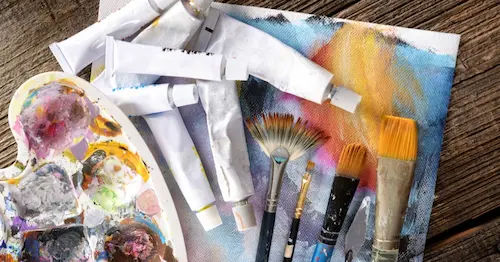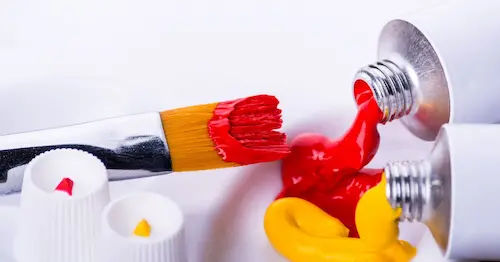Acrylic Paint

Do you have prior experience using acrylic paint? Acrylic paint is a very popular type of paint. It’s composed of acrylic and has a solid, long-lasting finish after drying. Some acrylics may be mixed with watercolor or another acrylic to produce a variety of effects. This blog post will teach you how to use acrylic paint in your arts and crafts projects!
You can also check other Virtual Workshop Singapore for more amazing online activities!
What is Acrylic Paint?

Acrylic paints are versatile and popular among both amateurs and experts since they are flexible. They dry quickly and may be thinned or washed with water, making them ideal for beginners!
Acrylic Paint Grades

1. Student Quality Acrylic Paints
Student grade acrylic paints are more cost-effective than professional grade paints since they utilize less expensive, less pure pigments rather than the high-end ones utilized by artists. In addition, they include extra components and extenders in greater quantities.
2. Artist Quality Acrylic Paints
Artist Grade Acrylic Paints are often high in single pigment colors and low in additives or extenders. The more pigments you add, the less vibrant they’ll become. The individuality of each pigment is emphasized by artist paints.
Types of Acrylic Paint
1. Heavy Body paints
The Heavy Body paints are the thickest and beefiest of all the other types, with a smooth texture. They’re comparable to oil colors in terms of application and have a softer buttery feel. They take well to rough surfaces.
2. Soft Body paints
The smooth, more yogurt-like feel of Soft Body paints makes them ideal for layering with mediums while yet providing enough thickness to paint freely and quickly.
3. Fluid paints
Fluid paints are smooth, creamy in texture and ideal for brushing or staining applications. They’re perfect for glazes and complex tasks due to their good flow.
4. Acrylic Ink
The most liquid of the acrylic paints is Acrylic Ink. It’s made up of tiny, super-fine particles dispersed in an innovative acrylic emulsion that flows like water. When dry, Acrylic Ink has a glossy sheen and is brightly colored. To make it, you may use an airbrush, pen, or brush to apply it.
5. Open paints
Open paints take a long time to dry, so they’re ideal for painting wet-into-wet and combining colors on the surface of your artwork. They’re great for painters that want to use oil techniques only.
6. Interactive acrylics
Interactive Acrylics are durable, artist-quality acrylic that is one-of-a-kind in terms of the ‘unlocking formula,’ a liquid that rewets dried interactive acrylic and slows drying as few drops are added to wet paint.
7. Acrylic Gouache
Acrylic gouache is a cream-like paint with a matte velvet finish. Brush markings are less obvious with this paint, which is consistent among artists. If you want to do large swaths of flat color in one session, try gouache.
8. Acrylic Markers
Acrylic paint markers are acrylic paint marker pens that may be used to mix painting and drawing techniques. Acrylic markers are designed to be high-coverage, fast-drying, water-resistant, and fade resistant. They’ll stain even bright surfaces with a brilliant hue or paint and adhere to most materials, including metals.
9. Acrylic Spray paint
Acrylic spray paint is a versatile type of paint that may be used on a wide range of surfaces. Some acrylic sprays include solvent, so if you use one with solvent, use one with a fume mask or in a well-ventilated area. Water-based paints do not create toxic fumes, making them safe to use indoors.
Acrylic Painting Tips for Beginners

1. Choosing your Brush
Choosing the incorrect tools may have a significant impact on the quality of your work. For acrylic painting, you’ll need a range of brushes ranging from tiny to huge for various techniques as well as many different paints. When laying down thick coats of paint, use a stiff-bristled brush. Use a soft-bristled brush for water-color effects like washing. The Filbert paintbrush is a excellent, all-purpose tool that comes in either a straight or circular form to fit your needs.
2. Underpainting
To create a “sketch” in paint before you begin painting, use a color that complements the palette you want to employ for your work. If you choose an opaque acrylic, any indications of the paint below will be hidden.
3. Palette Preparation
Acrylic painting palettes are ideal for mixing and matching colors on non-stick surfaces, such as a large plate or a tray with empty pockets. Using a broad palette may be more practical if you’re dealing with thick paints. You may simply apply many hues in broad areas with these enormous-area palettes, for example. If you’re working with a paint that has a higher viscosity, such as oil or acrylics, a palette with wells will be useful. Using a huge flat palette and low-viscosity paint might result in your colors mixing or running off the surface!
4. Paint in Color Blocks
This is an excellent approach for novices. Separate each hue or tone into its own form, and then paint the forms as though you’re doing your own DIY paint-by-numbers work. This is a simple method that may be used with monochromatic palettes or a wide range of colors.
5. Partially Mix Colors Before Painting
Instead of fully mixing the two hues, just stir them with your palette knife for a couple of seconds. Then use the combined but partially mixed colors to create artwork on your canvas. When you apply paint to a blank surface, you’ll be amazed at how many distinct tones it contains.
Acrylic Paint
What are you waiting for now that you know a little more about acrylic paints? Now is the time to get started on your next masterpiece! Acrylics have something to offer everyone, from novice to expert artist. Practice makes perfect, so keep at it and try new methods if you wish to enhance as an artist.
You can also check other Virtual Workshop Singapore for more amazing online activities!
If you’re interested in more articles like this, here are some other lifestyle articles that may appeal to you:
.webp)